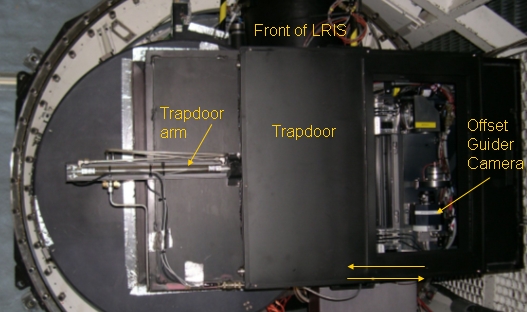LRIS: Trapdoor
The LRIS trapdoor is the access door to the front of the instrument. It can be either OPEN or CLOSED. In August 2004
the trapdoor mechanism was re-designed to accommodate the Cassegrain ADC requirements: the former swing
mechanism was replaced by a sliding hatch. The immediate advantage is that the trapdoor can open
and close in much less than the usual 15-20 seconds, and can be set as fast as 1 sec. In this mode, the trapdoor
can be used as a poor man's shutter everytime one of the camera shutters is broken.

Trapdoor functionalities:
- The trapdoor toggles an interlock mechanisms that prevents the calibration lamps to go on when the hatch is open. Therefore, if you turn on the lamps but you do not see light in your frames, tha trapdoor may be open.
- The trapdoor protects the two guiders when they are not in use. When the trapdoor is closed no light will reach the guiders. Therefore, if there is not signal on the guiders, check that the trapdoor is closed.
- The back of the trapdoor is used as a screen to reflect back the light of the internal calibration lamps. The door is painted with Spectraflet coating produced by Labsphere. Spectraflect is a specially formulated barium sulfate coating which produces a nearly perfect diffuse reflectance surface. Spectraflect is generally used as a reflectance coating in the UV-VIS-NIR region and is most effective over the wavelength range from 300 to 2400 nm.
The front of LRIS and the open trapdoor. Visible on the right is the offset guider assembly.

Send questions or comments to:LRIS Support